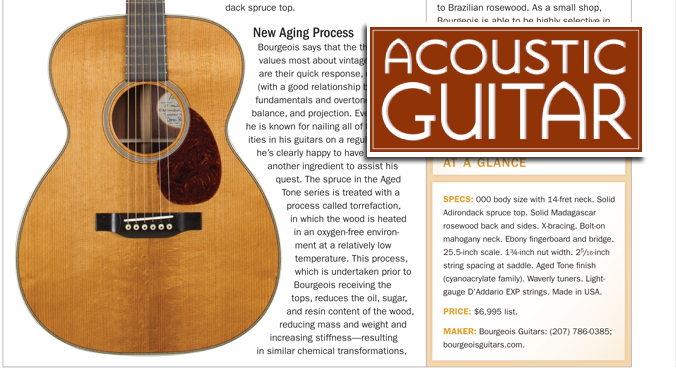Review & Articles
Bourgeois Aged Tone OM Vintage Review
From the January 2014 issue of Acoustic Guitar.
Read the PDF of the Full Article here
Bourgeois Aged Tone OM
Vintage-inspired OM with new top-aging
technique delivers great looks and rich tone.
By Teja Gerken
See the video review at AcousticGuitar.com
MAINE-BASED LUTHIER DANA BOURGEOIS has stood at the forefront of the vintage-inspired steel-string flattop field ever since building his first guitar in a dorm room in the mid-1970s. In the years since, he has collaborated with maker, player, and dealer Eric Schoenberg and C.F. Martin and Co. on the original batch of Schoenberg Soloists, a project frequently credited with bringing the OM (orchestra model) back to prominence in the 1980s. (The orchestra model is a 14–fret, 000-size, long-scale guitar with a 13/4-inch-wide nut originally built by Martin from 1929 to 1933.) Bourgeois employs a team of about a dozen luthiers, and the guitars have attracted such high-profile players as Bryan Sutton, Ricky Skaggs, and Ray LaMontagne.
Always on the lookout for ways to add an extra dose of “vintage” to his guitars, Bourgeois began experimenting with a specially treated spruce a couple of years ago. The result is Bourgeois’s Aged Tone series, which includes a variety of dreadnoughts and OMs. I had a chance to check out an Aged Tone OM built with Madagascar rosewood back and sides and an Adirondack spruce top.
New Aging Process
Bourgeois says that the things he values most about vintage guitars are their quick response, dry sound (with a good relationship between fundamentals and overtones), balance, and projection. Even though he is known for nailing all of these qualitiesin his guitars on a regular basis, he’s clearly happy to have found another ingredient to assist his quest. The spruce in the Aged Tone series is treated with a process called torrefaction, in which the wood is heated in an oxygen-free environment at a relatively low temperature. This process, which is undertaken prior to Bourgeois receiving the tops, reduces the oil, sugar, and resin content of the wood, reducing mass and weight and increasing stiffness—resulting in similar chemical transformations, Bourgeois says, that occur in wood over decades of air drying. Developed in Finland, the process was originally used on flooring, building sidings, and outdoor furniture, where it enhanced stability, durability, and appearance. A number of electric-guitar makers, including Anderson, Shur, Music Man, and others, have been using torrefied maple necks. Bourgeois also uses a new kind of finish on the Aged Tone series. Extremely thin, this cyanoacrylic finish combines the lowdamping factor of vintage nitrocellulose finishes with the durability of a modern, catalyzed finish.
Adirondack Meets Madagascar
For the guitar I received for review, Bourgeois paired an Aged Tone Adirondack spruce top with back and sides of Madagascar rosewood, a premier alternative to Brazilian rosewood. As a small shop, Bourgeois is able to be highly selective in the materials it uses, and the woods used on our review guitar are nothing short of spectacular. Though it doesn’t have the straightest or tightest grain (traits that some find attractive, but have little or no effect on tone), the top is perfectly bookmatched, with the center seam all but invisible and some areas with beautiful medullary rays. The top may look like it has been treated with some sort of aging toner, but this darkening is the true color of the wood itself, a result of the Aged Tone process. The back and sides of the guitar are made of some of the most gorgeously colored and figured Madagascar rosewood I’ve come across, without being so flashy that it would look out of place on a vintageinspired instrument. Matching Madagascar rosewood is used for the headstock’s veneer, where it adds a touch of class to the front view of the guitar.
Although the woods may look stunning, Bourgeois clearly chose them for their tonal attributes. You can get a good sense of the sound of this guitar simply by picking it up. As on a great vintage guitar, even the slightest knock on the body seems to sustain, and there is an incredible sense of life that is impossible to ignore even when you’re simply handling the instrument.
The other materials used on the guitar are also top-notch. The ebony fingerboard and bridge are dark black with no visible imperfections, the mahogany neck (which has a gentle V shape) is rich in color, and even the internal braces and other parts were clearly selected with care. And the OM’s craftsmanship matches its materials with flawless execution, beautiful finish, and lovely details such as a zipper-style backstrip and herringbone purfling.
Shining Bright Sound
OMs are often praised for their versatility, and, put simply, there was nothing I threw at this guitar that it couldn’t handle. With its 13/4-inch nut width and wide 25/16-inch string spacing at the saddle, the guitar has immediate appeal to fingerstyle players, who will also appreciate its quick response and ability to produce considerable volume without a lot of effort. But the Adirondack top also delivers the huge dynamic range and generous headroom the wood is prized for, making the guitar great for flatpicking as well.
I have played a lot of OMs built with Adirondack tops and rosewood-family back and sides, both vintage and new (I own a custom-shop Martin OM with an Adirondack top and Indian rosewood back and sides), and I’m often surprised at the wide tonal variation among these guitars. The Bourgeois was one of the brighter examples of this guitar type that I’ve played. And by bright I don’t mean brash or unpleasant in any way, but with singing trebles and an assertive overall tonal quality. The lack of dark, muddy bass tones means that it would work very well with a microphone, either onstage or in the studio. The guitar had an impressive stack of overtones, but it wasn’t so rich that the sound became cluttered. Even when I played note-heavy Irish tunes, such as a D A D G A D arrangement of “Banish Misfortune,” or such complex jazz tunes as Duck Baker’s arrangement of “Blue Monk,” this OM never sounded cloudy.
Besides playing the guitar at home, I also took it to an unamplified gig at San Francisco’s Bazaar Café. As I performed solo-fingerstyle tunes, as well as a few duets with other acoustic guitarists with whom I played single-note lines with a flatpick, the guitar continued to impress with its clarity, while delivering the volume and punch necessary to compete with other instruments in a purely acoustic setting.
Expectations should be high for a guitar in this price range, and I’m happy to report that the Bourgeois Aged Tone OM delivers in every way. If you’ve been looking for a high-end OM with vintage qualities, this one should be on your short list of guitar to investigate
at a glance
SPECS: 000 body size with 14-fret neck. Solid
Adirondack spruce top. Solid Madagascar
rosewood back and sides. X-bracing. Bolt-on
mahogany neck. Ebony fingerboard and bridge.
25.5-inch scale. 13/4-inch nut width. 25/16-inch
string spacing at saddle. Aged Tone finish
(cyanoacrylate family). Waverly tuners. Lightgauge
D’Addario EXP strings. Made in USA.
PRICE: $6,995 list.
MAKER: Bourgeois Guitars: (207) 786-0385;
bourgeoisguitars.com.

